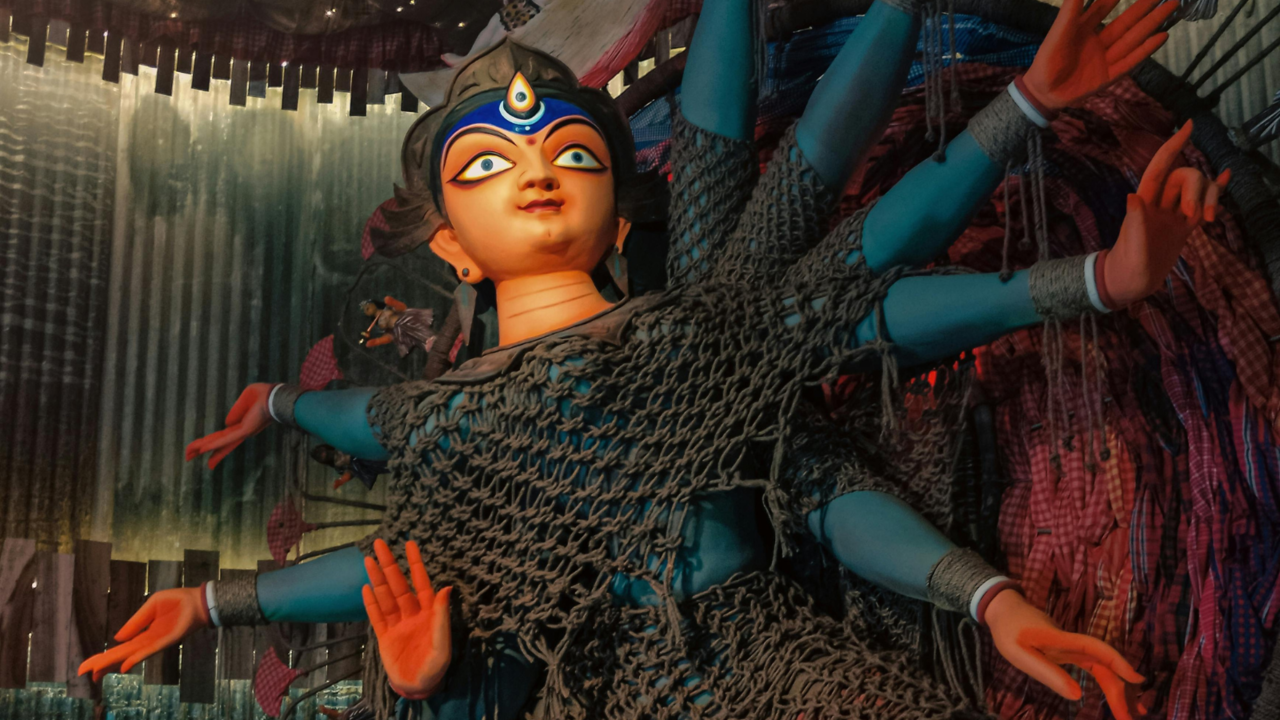
Durga Puja 2024: Growing up, little did many Bengali children know that the affectionately called ‘Kola Bou’ is not just the consort of Lord Ganesha, but has a greater significance in the larger scheme of things. For most, Saptami morning with start with elders from the para (neighbourhood) ceremoniously taking a banana plant to the Ganges, or alternatively the nearest water body for a ritualistic dip and worship, following which the ‘bou’ would be adorned in a shada paad laal saree (white saree with red border) or a banarasi and placed beside Lord Ganesha. For youngsters that signalled Ganesh thakur’s wife has arrived. But nothing could be farther from the truth.
“There is a lot of misconception regarding the Navapatrika among many Bengalis. People thing Navapatrika is Ganesh's consort. However that is simply not true,” explained miniature artist and history scholar Sumit Biswas in an exclusive interaction with Times Now. “A lot of people call the plant Kola-Bou. But that in itself is a misnomer, since nine plants are actually worshipped, reminiscent of Nature worship from civilizations as early as Harappa,” he explained.
Similarly, according to Subrata Bhattacharya, the head priest of the Central Noida Pujo Committee, which hosts the annual festivities at sector 78, adjacent to Ved Van Park, Durga Puja aligns with the harvest season, symbolising health, wealth, and prosperity. “At the core of Durga Puja is the belief that Goddess Durga returns to her mother's home on Earth from her bridal abode in Mount Kailash, accompanied by her children— the eldest Ganesh, and youngest Kartik, along with her daughters Lakshmi and Sarasvati.”
Also Read: Durga Puja 2024: Celebration Of Divinity Or Uma’s Homecoming?
Bhattacharya elaborated, “The Navapatrika ritual beautifully weaves together various beliefs, myths, and customs associated with Durga Puja. It involves bundling nine different plants and tying them with a sacred thread before placing them on a pedestal for worship. The plants are bathed in holy water and offered puja items like flowers, fruits, sweets, and incense sticks.”
Biswas offered a little bit of a historical context, explaining, “The worship of Mother Earth and plants have been prevalent since time immemorial since they were harbingers of life and sustenance. Even socially, if you visit villages you will see the simple folk worshipping the sacred fig and banyan trees. This ancient practice further finds voice during Durga puja by way of the Navapatrika.”
He went on to add that each plant is representative of a Devi. They are all taken to the River Ganges on the morning of Saptami, adorned in a saree, and placed on the puja podium within a speculated time.
According to Biswas, “It is only after Nature is worshipped does the actual invocation or Bodhon of Goddess Durga takes place.”
For the unversed, on Saptami, the seventh day of the festival, the invocation of Goddess Durga takes place in the Navapatrika, which is tied to the twigs of the white Aparajita plant (Clitoria ternatea) using a yellow thread. Each of the nine plants symbolises a form of Goddess Durga:
Banana is for Goddess Brahmani, while Colocasia symbolises Goddess Kalika. Turmeric represents Goddess Durga, Jayanti represents Goddess Kartiki and Bel leaves are symbolic for Goddess Shiva. Apart from these, Pomegranate leaves are looked at as Goddess Raktadantika, Asoka leaves symbolise Goddess Shokarahita and Arum is for Goddess Chamunda. Finally, Rice paddy represents Goddess Lakshmi.
“The Navapatrika receives a ceremonial pre-dawn bath in river or pond water, accompanied by chanting of the holy scriptures. It is then adorned in a red-bordered white sari, or a banrasi, depending upon the neighbourhood or home, smeared with vermilion on its leaves,” Bhattacharya revealed, adding that the Navapatrika is placed on a decorated pedestal and worshipped with flowers, sandalwood paste, and incense. She is later positioned beside Lord Ganesh, thus affectionately gaining the name Kolabou, or Ganesh’s wife.
According to Biswas, the best way of explaining the importance of Navapatrika during Durga Puja is its symbolic association with power and fertility. “These are the things we get from the leaves, plants and the earth. Each plant has its own medicinal properties. In many ways it is perhaps a pre-cursor to what has come to be known as forest conservation,” he explained.
Interestingly, the worship of Goddess Durga only commences once the nine plants – Nature – is worshipped.
On the final day of Durga Puja, known as Dashami, the Kola-bou is dismantled and immersed amidst the chanting of mantras. This ritual is performed in seclusion, as the Immersion Ghat is often crowded with onlookers. To maintain privacy, a large cloth is used to create a barrier around the Kola-bou, shielding it from prying eyes during the dismantling. This practice is significant, as the Kola-bou symbolizes Ma Durga herself, and the untying and unveiling must be done with the utmost respect. The idol's immersion occurs only after the Kola-bou has been immersed.

